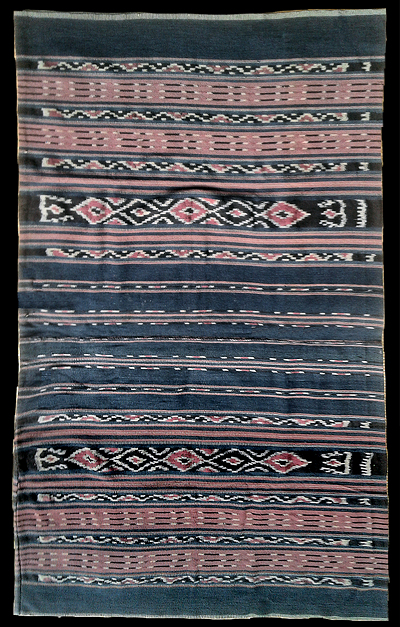| |
 
 | | | |
356 Moluccas, Kisar
Selimut (shawl)
| | Locale: | Probably made by one of the last mestizo weavers on the island. | | Period: | 19th to very early 20th c. | | Yarn: | Cotton, hand-spun, fine | | Technique: | Warp ikat | | Panels: | 2 | | Design: | This cloth is asymmetric, but the asymmetry is very subtle and easy to overlook. It is not just created by three pairs of short horizontal stripes, unequally dived over the two panels, but also by the distribution of the seven longitudinal bands along the seam: four to left, three to the right of it. The design is a fine example of the 'Pictorial Style' of the South Moluccas as described in Peter ten Hoopen's Ikat Textiles of the Indonesian Archipelago, p. 459. The large X-shaped motifs are a rudimentary version of the double-headed eagle motif studied in detail in the same author's Ikat from Timor and its Outer Islands: Insular and Interwoven, p. 118-128. The boxed-in eight-pointel stars (ibid: 136-140) are part of a narrative about ancestors' flight, and in this context stand for the place of arrival. It appears to be an emulation of a common Turkic motif, widely distributed in the eastern archipelago. The human figures with upraised hands are often called 'orant', though there is no indication of people in the eastern islands raising their hands in prayer. They are just as likely to be dancing as praying (ibid: 87, 110). They are the central element of a pictorial strip called rimanu that is also found on Luang and a few other South Moluccan islands. It often, as here, includes drawings of horses with or without riders, which stand for the ancestors' battles. | | Comment: | [PHOTOGRAPHY PROVISIONAL] Extremely rare, possibly unique specimen. From old Dutch collection. | | Background: | Chapters on Moluccas and Kisar. | | Compare: | 200 308 | | Sources: | Peter ten Hoopen, Ikat Textiles of the Indonesian Archipelago, p. 459. Ikat from Timor and its Outer Islands: Insular and Interwoven, pp. 86-97, 118-128, 136-140. | | |

©Peter ten Hoopen, 2025
All rights reserved.
|
|


